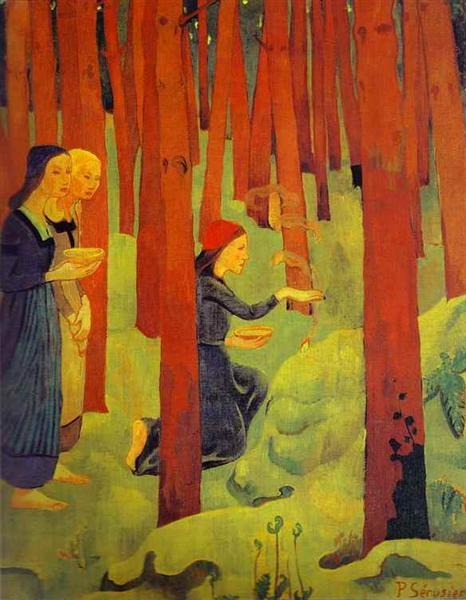1877 - 1890
Synthetism

description
1877 – 1890
Synopsis
The word ‘’synthetism’’ is derived from the French verb synthétiser (to synthesize or to combine so as to form a new, complex product). Synthetism is a term used by Post-Impressionists, such as Paul Gauguin, Émile Bernard and Louis Anquetin to distinguish their work from Impressionism. Synthetism is connected to Cloisonnism and Symbolism.
Key ideas:
The basic principles of Synthetism are the simplification of the scale of the pattern and forms, the use of color spots as a decorative element. The use of unusual, bright colors became a characteristic feature of Synthetism. Thus, the main idea of Synthetism was the unity of the imaginary world and the real world.
Synthetists tried to work less directly from nature and to rely more upon memory. They synthesized three features in their works:
– The outward appearance of natural forms.
– The artist’s feelings about their subject.
The purity of the aesthetic considerations of line, color and form.
Key artists: Louis Anquetin, Emile Bernard.
description
A Russian artist, master of domestic genre and landscape, member of the Association of the Wanderers, one of the founders of the Union of Russian Artists and a talented teacher.The central place among the narrative paintings was the leitmotif of the young peasant woman (the so-called “Arkhipov peasant women in red”), as well as landscapes depicting the expanses of the central Russian zone and the north.
1862 - 1930
description
Jens Ferdinand Willumsen was a Danish Symbolist artist, most of whose career was in France.He was born into the family of an entrepreneur who lived and worked in Copenhagen.Jens Willumsen was close to the creative school of Pont-Aven, due to his acquaintance with Paul Gauguin and collaborated with the artists of the Nabi group, taking part in collective exhibitions. He was one of the organizers of the "Free Exhibition" in Copenhagen, which united avant-garde artists of Denmark and was the architect of the exhibition pavilion of the group. Willumsen worked as a painter, graphic artist, engraver, ceramist, sculptor, architect and photographer. He used almost all available art tools and boldly experimented with the form, color and material in his works.
1863 - 1958
description
An English artist and designer. She was a member of the creative group "Bloomsbury", the participants of which were British intellectuals, talented painters and poets.Vanessa Bell, maiden name Vanessa Stephen, was born into a creative family. The artist's father was a famous historian, literary critic, theologian and climber Leslie Stephen, who gave his daughter an initial art education. The sister of the artist was famous writer Virginia Woolf.Vanessa Bell was among the first artists who dared to break the barrier between Britain and the mainland. She not only boldly used the methods of Post-impressionism and Art Nouveau in her work, but also actively developed avant-garde movements in England.
1879 - 1961
description
An English artist and innovator, animal painter and landscape painter, draftsman and master of lithography.Robert was born into the large Quaker family of rich banker Richard Alexander Bevan and Laura Maria Polhill, who lived in East Sussex (the town of Hove near Brighton).He was one of the most active members of several progressive associations of artists in Britain - Kemden Town group, renamed the London Group (the London Group), the association "Fitzroy-Street." He founded the Cumberland Market group and was elected a member of the New English Art Club (NEAC).The first large memorial exhibition of Robert Bevan was held in 1926, then several more times. Children, who received an inheritance in equal parts, presented part of the parents' works to the Ashmolean Museum of Art and Archeology, Oxford, Great Britain.
1865 - 1925
description
A Dutch painter, a bright representative of Post-impressionism.The artist was born and raised in the wealthy Jewish family of an entrepreneur.Being a close friend and follower of Paul Gauguin, Meijer de Haan played an important role in the development of Synthetism not only in his homeland. Despite the great influence of Gauguin, he found his own style in painting and created rather distinctive portraits, still lifes and decorative works. The artist's creative life turned out to be rather short; after refusing to travel with Gauguin to Tahiti, he practically stopped painting and ended his life in obscurity. Only a few dozen works of the painter have survived; they are mainly stored in private collections.It is still unknown why the gifted artist, passionate about painting, did not continue his career. Perhaps the decision of de Haan was influenced by the departure of Gauguin to Tahiti, or Theo Van Gogh’s early death, or perhaps it was the pressure from relatives who stopped sending him money; after 1891 the artist did not create a single canvas. He returned to the Netherlands, where he died in obscurity, leaving behind only a few dozen extraordinary and certainly talented canvases.
1852 - 1895
description
The biggest representative of Post-impressionism and partially Symbolism; however, his early works were created in the style of impressionism. He is considered the forerunner and one of the pioneers of the art of modernism (in the broad sense of this term) not only in painting, but also in sculpture and graphics.Gauguin began painting as an amateur in the 1870s. Soon he actively participated in exhibitions. He became worldly famous only after his demise. And at the end of the 20th century, biographical films about his life were created.
1848 - 1903
